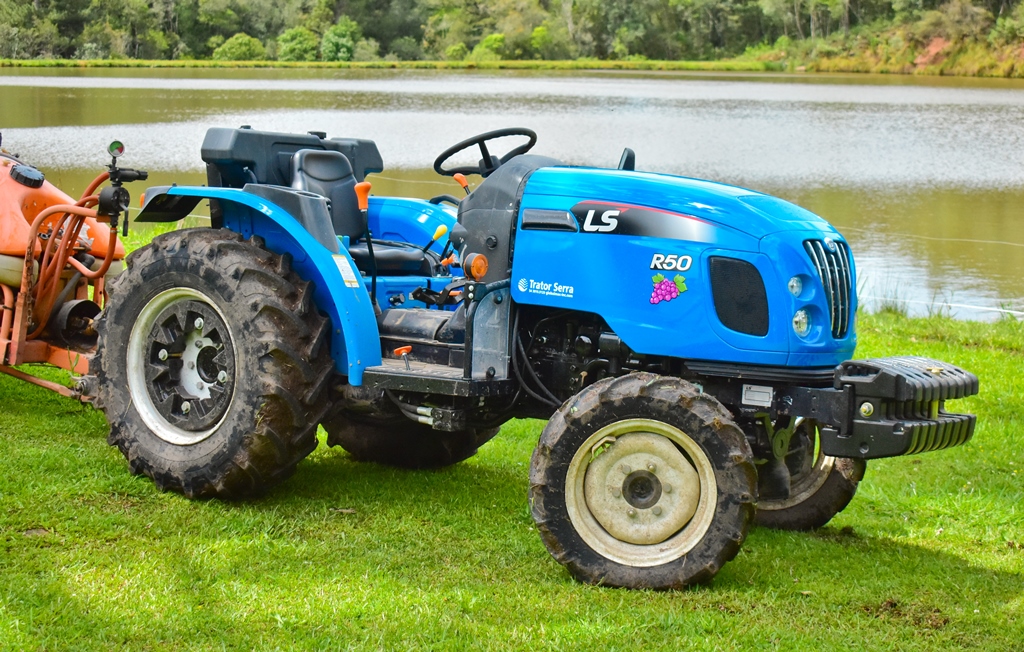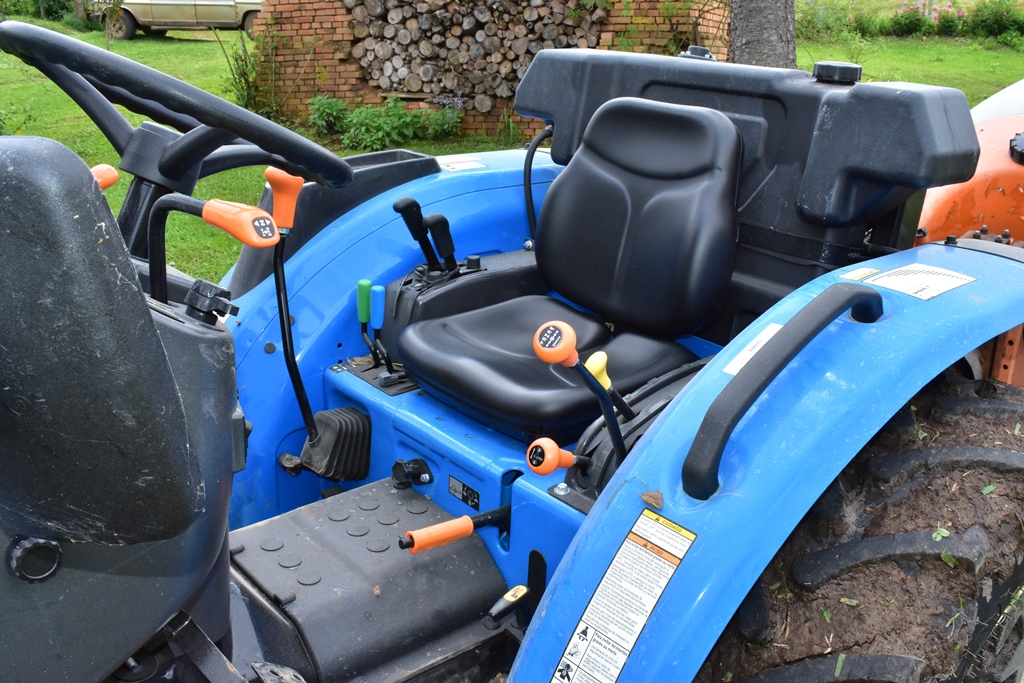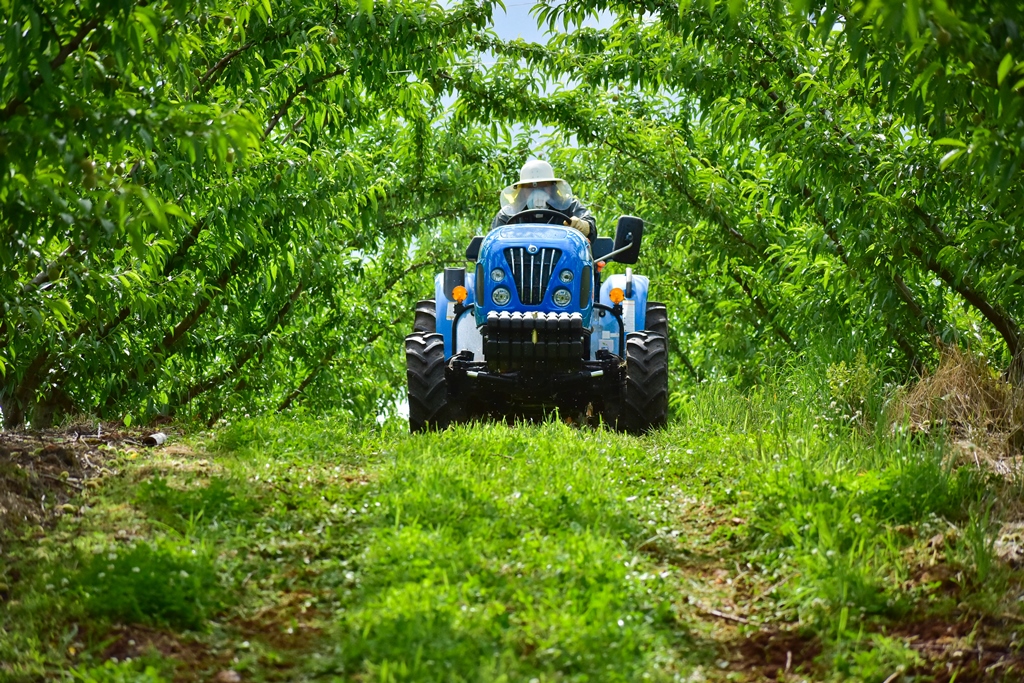Soybean planting: how the use of new technologies can improve the initial performance of your crop
What are the most common stresses that can occur in farming and how to prevent it?
With a version designed for work in activities and crops that require reduced dimensions, the R50 tractor from LS Tractor brings several differentiators to the 50hp tractor range
In the somewhat more distant past, tractor manufacturers offered a model to the market with only two tire options: R1 (thigh) or R2 (rice tire). Later, manufacturers started to offer a basic model and the customer added optional components, making their version on demand. The final price of the tractor was only materialized when the customer defined all his choices. In this edition's Test Drive, we will talk about an LS Tractor model, with modifications that make it special for a specific use, constituting an adapted version.
The R50 tractor, already known and established in the Brazilian small tractor market, gained a special version, resulting from customer demand, mainly in viticulture, but with application for other fruit crops that suffer from the same restrictions, mainly related to reduced space. This version was designed to provide work under a vegetation cover, positioned at a height of approximately 1,60m to 1,70m of free vertical space. These activities, distributed throughout the country, but with a predominance in the South region, are quite significant in the cultivation of temperate fruit crops and needed a tractor that would allow mechanization in the different phases of the crops and, mainly, in the management of the vine in the trellis system. , where the posts, cable ties, supports and wires are positioned in this way. However, other crops such as peaches, plums, persimmons and apples, and even work inside poultry houses, became possible with this resized model.
Modifications were made using an R50 tractor, which we will report in this article and relate to field work in fruit trees. These adaptations occurred mainly in reducing the maximum height and relocating the operator to his workstation.
The engine fitted to this tractor is the LS brand, model S4QL, four-cylinder, 2.505cm3, mechanical and direct fuel injection and natural aspiration. It meets the Tier 3 emission control standard and provides 50 hp of maximum power, according to the ISO TR 14396 standard, at a speed of 2.600 rpm. Maximum torque is 147Nm, reached at 1.600rpm.
To transmit power and torque, everything starts with a mechanically driven clutch that uses a disc with organic material. The gearbox is of the Synchro Shuttle type, with 32 forward and 16 reverse gears, with reverse gear and super-reducer (Creeper), which provides very low travel speeds for special operations that require this feature.
The supply of power in rotary movement is made by the power take-off (TDP), which is of the independent type with electro-hydraulic drive, with three angular speeds, the most common standard being 540rpm, 1.000rpm and the economical mode which is the angular velocity of 750rpm.

Regarding the use of power in hydraulic form, it is possible to take advantage of it in two ways. The first mode is the three-point system of the hydraulic system, category II with a total flow of 47 liters per minute and a maximum pressure of 200bar, reaching a lifting capacity of 1.800kgf, measured at the joint joint of the lower arms. . The drive system is conventional with two levers with position and depth control. The second way of using hydraulic power is through the valves of the remote control system (VCR), which can be two in the standard version and three as an option. The maximum flow rate is 31 liters per minute.
The brakes consist of two discs in an oil bath, with mechanical actuation and a parking brake activated by a lever.
This tractor is of the auxiliary front-wheel drive (TDA) type, with a driven front axle, which can be disconnected using an electro-hydraulic control. For better handling and traction, with the set of radial tires that equip this model, the internal tire pressure must be 30psi on the front wheels and 20psi on the rear wheels. Thus, the static weight distribution between axles is 47%/53%, front and rear, respectively, resulting in a kinematic ratio between axles between 2% and 4%, which is very favorable.
On the rear axle, between the differential and the wheelsets, there is an epicyclic final reduction. The differential lock is mechanical.
The main motivation for building this modified version, which does not exactly characterize itself as a new version, was due to the restrictive conditions for movement and operation of this tractor in the temperate climate fruit growing environment. In apple production, for example, the cultivation system only presents the tractor width restriction, with the distance between rows of plants of approximately 4m, with the development of branches and branches corresponding to a free horizontal space of 1,60m. , so that the tractor must have, at most, a total width less than this dimension so as not to collide with the branches and fruits on the side. The height problem is not relevant in this culture.

In the case of plums, although the spacing between rows of plants is even greater, from 1,50m onwards there is a convergence of branches and twigs in the middle of the row and the height becomes a problem, with the impossibility of operating with tractors with conventional safety arc and requiring smaller dimensions of the operator's position.
With peach cultivation, the problem worsens, as with the open cup pruning system, the branches project towards the row and into the space between rows, with several producers creating a kind of tunnel, tying branches that project. to the center of the streets. The height then reduces to approximately 1,50m to 1,70m and the vertical reduction of the operator's seat position becomes essential. In this condition we saw the importance of modifications and how relevant they can be to avoid mechanical shock against flowers and fruits, especially in mid-cycle chemical product application operations.
In grape production, in the trellis system, the resized product stands out and justifies the manufacturer's action in reducing the total height, since the height of the horizontal fence structures is approximately 1,70m from the ground, and takes Take into account that the majority of these vineyards are located on sloping terrain, when in certain points these reference heights are even lower. It is also important to consider that any type of mechanical shock must be avoided at this point in the entire production cycle.
It should be noted that there was already some experience of modifications made by users and dealers, ideas that ended up being used by the manufacturer and improved in the industrial process.

The main modifications promoted by factory engineering in this model were the lowering of the operator's seat level, with the elimination of the vibration damping system, and the installation of a seat fixing structure. As a result, the manufacturer was forced to lower the platform floor and specify smaller diameter wheelsets.
The lowering of the platform floor was a result of maintaining the operator's adequate position, as it is not enough to simply reduce the height of the seat and not adequately position the lower limbs, especially the angle between the thigh and leg. Due to the reduction in height, the conventional protective arch (Rops) was also removed, which made the total height reach almost 2,5 meters. Considering the ground level with tires measuring 12.4-24 on the rear axle and 8-16 on the front axle, the height of the seat base was reduced from 1,085m to 0,945m, that is, the seat was lowered by more than 23 centimeters.
With the installation of smaller diameter tires, of the radial type, the entire tractor's vertical dimensions were reduced, with the center of the steering wheel lowering by almost 15cm. The tread used, of the radial type, has a specification of 200/70 R16 on the front axle and 320/70 R20 on the rear axle. These dimensions are significantly reduced in relation to competing tractors in the same power range, however, equivalent to the measurements of tractors with lower power offered on the market. Some changes resulted from others, such as the redesign of the brake pedals.
With these modifications, the fuel tank remained in the same position, protruding in relation to the operator's seat, meaning it was not necessary to change its position.
To verify the effectiveness of the modifications in relation to the original project, we visited two rural properties in Serra Gaúcha, in the town of São Gotardo – Capela, in the district of Vila Seca, municipality of Caxias do Sul.
At the first location we visited the Bassanesi family property, where we were welcomed by two of the four brothers who explore the cultivation of the burgundy grape variety, suitable for table wine and juice. We found the brothers João Fernando and Pedro Antônio Bassanesi applying phytosanitary products to the vine, including a product with the active ingredient procymidone, a systemic one for controlling gray mold (Botrytis cinerea), and the foliar fertilizer Capitán. It was gratifying to see all the care taken by the family, both in supplying the product and in protecting the operator with full PPE.

During the flowering season, a mechanized set consisting of the LS model R50 tractor with the aforementioned adaptations and a Jacto turbo atomizer was being used. The brothers spoke positively about the changes made, as they greatly satisfied the operator's position and the height of the tractor. For them, the R50, which has an excellent turning radius, and the trailed sprayer connected to the traction bar formed a good combination for maneuvers, especially when maintaining height, something that does not happen with sprayers connected to the three points of the hydraulic system. , which fluctuate the application height with changes in the terrain profile.
The total area is 11ha, cultivated only with vines, and is subdivided into two areas, one of nine hectares, 21 years old, and the other, close to the family homes, approximately 30 years old. They conduct the activity with the aim of delivering juices to wineries in the region.
The workforce for most of the activities on the property is family, with the four brothers, João Fernando's son-in-law, Edelvan Schmeling, who has a partnership with his brother Pedro Antônio, and their wives, who help in times of greater labor demand. of work. On several occasions, neighbors are also called to work, especially during the harvest, which requires 10 to 15 people and lasts approximately 20 days.
The biggest motivation for purchasing this model was the need for a suitable tractor for product application operations, which corresponds to the greater number of hours of mechanized work. Previously, they used a tractor from another brand that was uncomfortable and very loud, requiring care and presenting several operational difficulties. According to Mr. João Fernando, the great advantage was the greater comfort in operation, mainly due to the electro-hydraulic controls, which brought speed and convenience. According to them, the adaptation improved the machine a lot and the height was adequate. Regarding the performance of the tractor, they reported being very satisfied. Regarding maintenance, it was not possible to make considerations, as the tractor only has 50 hours and has not yet required any action.

They also demonstrated a lot of satisfaction with the service provided by the LS Tractor Trator Serra dealer, both in the acquisition, which was made through a cash deposit and the remainder with direct financing from the company, as well as in the technical delivery and in answering the doubts that arose at the beginning. of the operation. Before purchasing, the family participated in a demonstration of the model on a neighbor's property and were convinced that it would be a good choice.
After visiting the Bassanesi family property, we headed to a nearby area, belonging to the Zanette family, owner of the company Zanette Frutas, being received by the agronomist Gian Carlo Zanette, who kindly explained to us the production systems and made considerations about mechanization and the insertion of this new model.
The family, made up of Gian Carlo's parents, sister and grandparents, produces 5ha of persimmons, 5ha of peaches, 7ha of grapes for juice and wine and 1,5ha of plums. The production is sent directly to the states of Paraná and Minas Gerais.
The production area is recent, was acquired in the 2017/2018 harvest and has a high degree of organization and use of technology. The greatest difficulties reported occur during harvesting, which depends heavily on labor, which is increasingly scarce, and phytosanitary treatment operations, which mainly require good machinery and effective fungicides and insecticides.
The company has its own cold room, properly preserving and preparing products for transportation, generally out of state and carried out by third parties. With increasing investment in production and quality, the family is implementing an irrigation system located in 100% of the area, starting from this harvest.
At the end of our day following the activities of the R50 tractor, we can say that we found customers satisfied with the modifications made to the tractor, with problems arising from crop particularities having been resolved, thus meeting customer requirements.

In the two cases we visited, the biggest problem is the issue related to family succession, with common difficulties. The big issue is that the factors that lead to rural exodus, such as the harshness of work in the field and the opportunities for urban work in an industrial region like Caxias do Sul, must be neutralized with the use of mechanization and technology, in the sense of increase comfort and quality of life.
LS Tractor is a company with origins in South Korea, derived from the LG Group, which began its activities in 1976 in South Korea. The LS Group was founded in 2005, starting with the production of R series tractors, such as what we had the opportunity to learn about in this and other editions of Revista Cultivar Máquinas.

LS Mtron was founded in 2008 and, only in 2012, Brazil began to receive tractors that soon began to be sold and inserted into the national market, currently organized into a portfolio of five series tractors, Plus Series, U Series, R Series, G Series and H Series and the MT1.25 tractor. In the beginning, the tractors sold on the national market were all imported from South Korea, and in 2013, the company began the nationalization of the models that the brand currently offers and exports to several countries in South America and Africa. The inauguration of the factory in Brazil took place in 2013, and the construction process took just one year. The brand has manufacturing units in Garuva, in the state of Santa Catarina, the traditional factory in Jeonju-si, in South Korea, and a recent installation in China. In total, it has an annual tractor production capacity of around 50 thousand units.
The manager of the main store in Caxias do Sul, local dealership Trator Serra, Mr. Julio Cesar Carniel, accompanied us during the test, carrying out the entire visiting strategy and logistics. The store opened in April 2013 is consolidated, with an excellent sales and customer support structure. In addition to the Caxias store, Trator Serra has outposts in Veranópolis and Vacaria.
José Fernando Schlosser
Leonardo Nabaes Romano
Rovian Bertinatto,
Federal University of Santa Maria

Receive the latest agriculture news by email